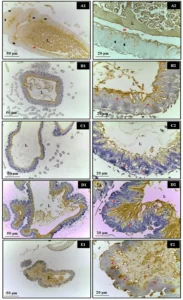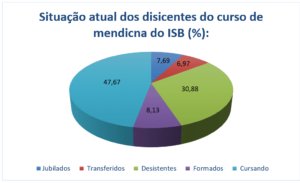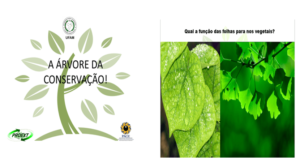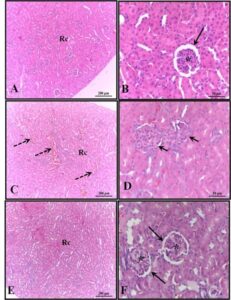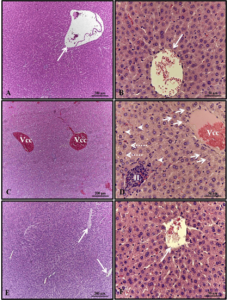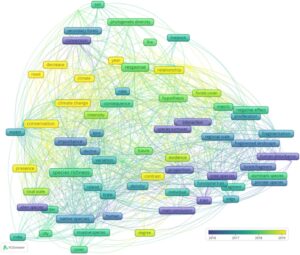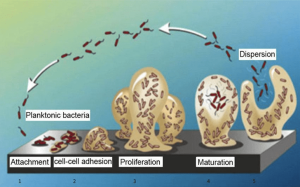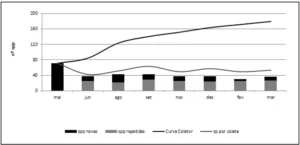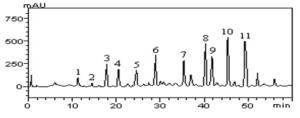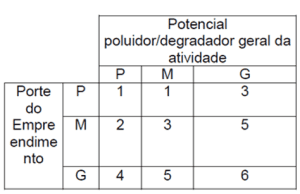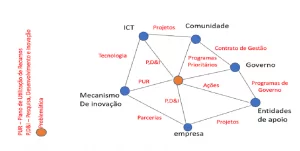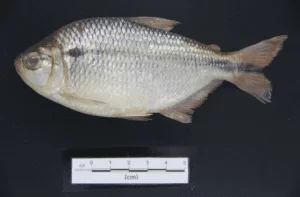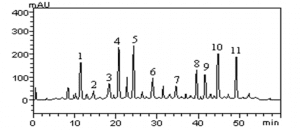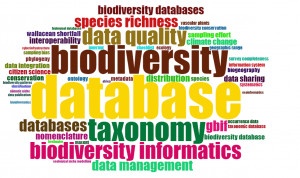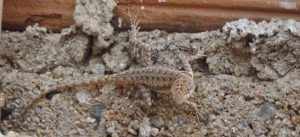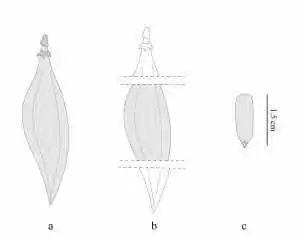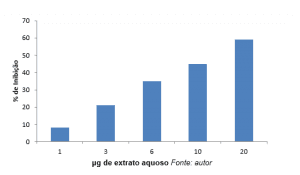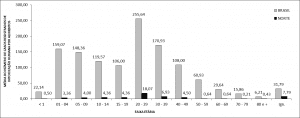REVIEW ARTICLE
REIS, Bianca Nunes dos [1], NASCIMENTO, Marcelo Trindade [2]
REIS, Bianca Nunes dos. NASCIMENTO, Marcelo Trindade. Functional attributes in ecological restoration in tropical forests: strategies and perspectives. Revista Científica Multidisciplinar Núcleo do Conhecimento. Year 09, Issue 02, Volume 01, pp. 153-175. February 2024. ISSN: 2448-0959, Access link: https://www.nucleodoconhecimento.com.br/biology/ecological-restoration-in-tropical, DOI: 10.32749/nucleodoconhecimento.com.br/biology/ecological-restoration-in-tropical
ABSTRACT
Tropical forests harbor high biodiversity but are facing intense fragmentation and isolation due to deforestation. The conservation of these forests requires reducing deforestation, restoring degraded areas, and expanding protected areas. Restoration areas are typically environments with different degradation histories, low nutrient availability, and high environmental variability. In this context, the use of functional groups has been employed to assess the successional trajectory of secondary forests. This study conducted a review based on empirical and theoretical literature available in the Scopus® and Web of Science® indexing databases over the past 10 years (2012-2022) within the theme of “functional attributes in ecological restoration.” In total, 1,941 publications were found. We evaluated and discussed the literature found through a theoretical approach to the content of the articles. Our research showed that functional characteristics in restoration areas are associated with multiple ecosystem service functions, including supporting, provisioning, regulating, supporting, and cultural services. We identified studies emphasizing the importance of considering functional attributes (response attributes and effect attributes) when selecting species for use in restoration projects. However, the functional approach in restoration projects, although growing in recent years, is still in its early stages. Given the challenges posed by the restoration decade, understanding the relationships between functional attributes and ecological restoration in tropical forests is necessary to fill existing gaps. We also emphasize the importance of disseminating and making local information on functional attributes available in data repositories to improve access to this information.
Keywords: Review, Restoration Decade, Tree Component, Functional Attributes, Ecosystem Services.
1. INTRODUCTION
Ecological restoration is defined as “the process of assisting the recovery and establishment of an ecosystem that has been degraded, disturbed, or destroyed” (SER, 2004). The key ecosystem attributes for ecological restoration are related to species composition, structural diversity, ecosystem functionality, absence of threats, physical conditions, and external exchanges (McDonald et al., 2016). In this sense, aiming at organizing restoration projects, principles for the practice of ecological restoration (Standards) were established. These standards provide guidelines for carrying out ecosystem restoration activities (Gann et al., 2019; Moraes et al., 2019).
On a global scale, tropical forests harbor high biodiversity distributed in generally fragmented and isolated areas (Brancalion et al., 2019, Brinck et al., 2017). Isolation and forest loss caused by deforestation in the tropics reduced the area by 12.2 million hectares of tree cover in 2020, with the loss of 4.2 ha of tropical primary humid forests (GFW, 2022a; 2022b). Therefore, actions to conserve the remaining tropical forests are necessary to avoid mass extinction events in the coming decades (Chazdon & Brancalion, 2019). Conservation of tropical forest areas involves restricting the destruction of forest remnants, restoring degraded areas, and expanding protected areas.
In this sense, the Convention on Biological Diversity (CBD) held in Rio de Janeiro in June 1992 established guidelines for the conservation of biological diversity, sustainable use of biodiversity, and fair and equitable sharing of the benefits of genetic resources (MMA, 2000). Among the guidelines established were the 20 Aichi Biodiversity Targets, including the creation and maintenance of protected areas covering at least 17% of the continental area, including territorial waters, marine and coastal areas (CDB, 2023). One of the proposed strategies is to assess the current level of degradation of ecoregions (Olson & Dinerstein, 2002) and seek to balance the results through a cost-benefit relationship of restoration projects in areas with few protected areas. The current scenario demonstrates that ecoregions with the greatest deficiencies are tropical and temperate forests, regions that have highly anthropized lands (Mappin et al., 2019). Given this scenario, we must propose initiatives to mitigate land misuse and anthropogenic impacts through the use of ecological restoration projects to reverse an agricultural or pasture landscape matrix (Arroyo-Rodríguez et al., 2013).
From a global perspective on the restoration theme, we can list international initiatives to recover forests and landscapes. One of these initiatives is the global commitment of the Bonn Challenge (Dave et al., 2019), which set targets to restore 150 million hectares of degraded and deforested landscapes by 2020 and 350 million hectares restored by 2030, as proposed in the New York Declaration (Suding et al., 2015). Aligned with these efforts, the UN established the Decade on Ecosystem Restoration in the world (2021-2030) through the United Nations Environment Programme and the Food and Agriculture Organization of the United Nations (FAO) (UNEP, 2019). In 2016, Brazil committed to restoring 13 million hectares by 2030, with 1 million committed through a partnership with the Atlantic Forest Restoration Pact (Bonn Challenge et al., 2020). Currently, ecological restoration faces some problems in the development of forest composition, such as dispersal limitation (Holl, 1999), recruitment (Palma et al., 2020), low taxonomic and functional beta diversity (Rother et al., 2019). New challenges have emerged when the focus was directed towards aspects of species characteristics, one of which is related to the fact that tree planting, although of different species, but with the same functional characteristics, can interfere with the successional trajectory and consequently homogenize the landscape (Manhães et al., 2022; Brancalion & Holl 2016; Palma & Laurance 2015).
Approaches based on functional attributes are alternatives to connect the functioning aspects of organisms individually with the structure and dynamics of the community (Zakharova; Meyer; Seifan, 2019). These can be described by physiological, morphological, or life history characteristics (Violle et al., 2007). The functional composition of species can affect some community parameters such as decomposition, soil fertility, biomass increment, wood density, establishment, and seedling survival in restoration projects (Rosenfield, 2017; Dias, 2014; Martínez-Garza; Bongers; Poorter, 2013).
The use of species’ functional attributes in restoration projects is fundamental to provide crucial information on factors that promote or limit the effectiveness of forest ecosystem restoration. This analysis allows for a more accurate identification of the elements responsible for success in the restoration process. Considering all the aspects presented here regarding the major challenges of the restoration decade, we can affirm that it is necessary to understand the responses of species in different conditions of degraded areas.
2. MATERIALS AND METHODS
This review was conducted through a bibliographic search of articles published in scientific journals indexed in the Scopus® and Web of Science® databases.
The first step was the selection of the theme “Functional attributes in restoration areas in tropical forests” and the delimitation of a 10-year timeframe (2012-2022). The second step was the search for articles in the bibliographic databases using the terms (restor* OR reflorest* OR recover OR regenerate OR revegetation OR recovery OR repair OR reconstruction) and (“function* trait*” OR “application *trait*” OR “strategy*trait” and “attribute”) and (“Tropic*” AND “Forest*”) and (“Tree*”). The third step was the exclusion of duplicate articles in the database using the Rayyan application (Ouzzani et al., 2016), and the fourth step was the selection of articles that met the criteria of Restoration, Functional Attributes, Tropical Forests as central topics in the article.
3. RESULTS AND DISCUSSION
The survey conducted in this research obtained a total of 1941 publications for the period 2012-2022 that met the criteria established in the search. We identified in the literature that the approach to the topic in the articles was small (<20 publications/year) in the 1990s. However, after the establishment of the concepts of functional traits (Violle et al., 2007), there was an advancement in the restoration theme, reflected in the increase (>100 publications/year) in the number of research articles addressing the use of functional attributes in restoration in recent decades, as evidenced in recent review articles (Loureiro et al., 2023; Carlucci et al., 2020; Caruso; Mason; Medeiros, 2020).
The use of functional attributes in restoration allows for the organization of species or individuals into groups with similar functions or responses. We can classify attributes according to their characteristics, which can be termed response attributes and effect attributes (Lavorel & Garnier 2002). Response attributes determine how a species responds to disturbance or changes in abiotic or biotic processes in its environment (Lavorel et al., 1997; Lavorel & Garnier, 2002), while effect attributes are characteristics that determine the effect of plants on ecosystem properties (e.g., soil cover, biomass increase, natural regeneration, biogeochemical cycling).
In the scenario of tropical forest degradation, restoring and studying the relationships between species characteristics and the environment should be highlighted on the global ecology stage. Among the first initiatives, we can highlight the study by Wright et al. (2004), which describes the main chemical, structural, and physiological properties for leaf characteristics (“leaf economic spectrum” – LES). The main characteristics described were: Leaf Mass per Area (LMA), photosynthetic assimilation rate, Leaf Nitrogen Content (LNC), Leaf Phosphorus Content (LPC), or leaf lifespan. In high-light environments, such as planting environments in general, we must initially consider leaf attributes (Schulze et al., 1998, Fonseca et al., 2000; Wright; Reich; Westoby, 2001; Wright et al., 2004). Leaves are influenced by environmental factors, showing changes in leaf construction strategies and resource allocation that can vary according to the intensity of investment (Volis; Ormanbekova; Yermekbayev, 2015; Wright et al. 2004).
Another important aspect is related to the characteristics of the stem economic spectrum. Through the characteristic of wood density in the stem, we can verify the plant’s structural strength. Thus, species with higher values of wood specific density (Wood density – WD) present better mechanical stability, greater height, better resistance to pathogens (Chave et al., 2009; Poorter et al., 2008). Conversely, lower wood density values of species make trees grow more in volume, have greater water conductivity and storage, and have thin bark (Chave et al., 2009; Baraloto et al., 2010).
New concepts were added to functional characteristics by Reich (2014), who began to include stem characteristics such as hydraulic conductivity, wood density, root characteristics (root length, longevity, and mycorrhizas) as attributes that assist in species performance and fitness. Reproduction characteristics were also included in a two-dimensional spectrum with plant size and leaf economy (Díaz et al., 2016).
The approach of functional attributes and ecosystem services began to gain emphasis after the works of Diaz et al. (2007) and De Bello et al. (2010). Some studies demonstrate that a species’ functional profile is linked to resource characteristics: resource acquisition, resource limitation, reproductive investment, and resource allocation patterns (Ostertag et al., 2015). It is currently seen as a major challenge to determine which species characteristics determine which ecosystem services (Kollmann et al., 2016; Carlucci et al., 2020, Pan et al., 2021).
Ecosystem services are the benefits that people obtain from ecosystems, and they are subdivided into provisioning services, regulating services, cultural services, and supporting services (MEA, 2005). Restoration projects can and should have various effects on ecosystem services (e.g., soil attributes, water resources, carbon reservoir, and biodiversity protection), as observed by Shimamoto et al. (2018) in a meta-analysis in tropical forests, where it was found that restoration actions positively contribute to ecosystem services when compared to disturbed areas.
The approach to functional characteristics in restoration projects remains incipient (Loureiro et al. 2023), with few works connecting environmental conditions, functional characteristics, and ecosystem functioning in community assembly (Zirbel et al., 2017; Weiher et al., 2011; Lavorel & Garnier 2002; Díaz & Cabido 2001). Given the challenges posed for the restoration decade, a greater understanding of the role of functional attributes (response attributes and effect attributes) in restoration areas is necessary to fill existing gaps.
As highlighted by Rosenfield & Müller (2020) and Zupo et al. (2022), currently, in the scenario of climate change and land use changes, restoration projects must consider, in their planning and monitoring, not only the floristic composition but also the functional characteristics of species and the ecosystem. However, the approach of functional attributes in restoration depends on the availability of information on these characteristics for the species used (Carlucci et al., 2020; Petisco-Souza et al., 2020). As warned by several authors, while functional characteristics for a few species are widely studied, many functional characteristics of species remain unstudied (Noble & Gitay, 1996; Grime et al., 1997; Lavorel et al., 1997; Weiher et al., 1999; Craine et al., 2002; Wright et al., 2004), especially species without economic use or species occurring in remote areas, far from urban areas and outside conservation units.
In their systematic reviews, Pan et al. (2021) and Carlucci et al. (2020) highlighted the most important points related to plant functional characteristics and ecosystem services. According to Carlucci et al. (2020), addressing functional characteristics and ecosystem services in tropical ecosystem restoration projects is challenging. However, caution must be exercised in this approach, as according to Gornish et al. (2023), what is lacking is a broad dissemination of information in a scientific format since this information is often in technical format through professionals with extensive local knowledge. In turn, in the systematic review by Loureiro et al. (2023), the authors highlighted that functional restoration is in the theoretical field and that new initiatives should be expanded to experimental approaches. These authors pointed out the challenges for the scientific community in linking empirical knowledge of professionals with the practical application of functional response characteristics (e.g., seed size, leaf nitrogen and phosphorus content, root dry mass) and effect characteristics that promote changes in ecosystem structure and functioning in restoration projects. The greater number of studies found regarding response attributes compared to studies addressing effect attributes indicates gaps in the knowledge of the relationships between characteristics and functions.
In this context, information on functional attributes allows for the relationship of biotic and abiotic components at the ecosystem level, providing information on community assembly mechanisms in environmental change processes (Laughlin, 2014) and can serve as a subsidy to predict ecosystem services (Garnier & Navas, 2012). According to Pan et al. (2021), ecosystem services are divided into three categories: provisioning services, regulating services, and supporting services. From this division, analyses were carried out to understand which functional characteristics affect each ecosystem service. The ecosystem was observed to be multifunctional, with multiple functions and ecosystem services occurring simultaneously (Table 1), requiring further discussions and in-depth analyses on the subject.
Table 1 – Survey of functional characteristics related to different ecosystem services proposed by the Millennium Ecosystem Assessment 2005 (MEA)
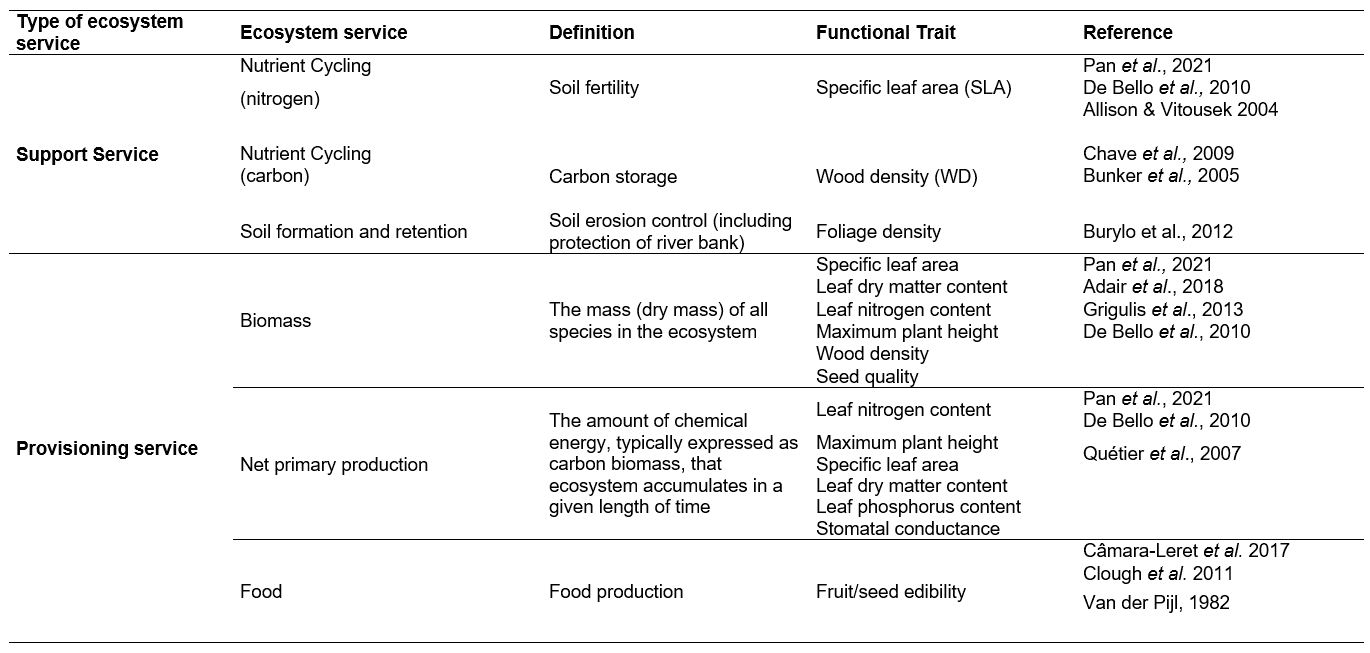
Table 1.1 – Continuation of the Survey of Functional Characteristics Related to Different Ecosystem Services Proposed by the Millennium Ecosystem Assessment 2005 (MEA)
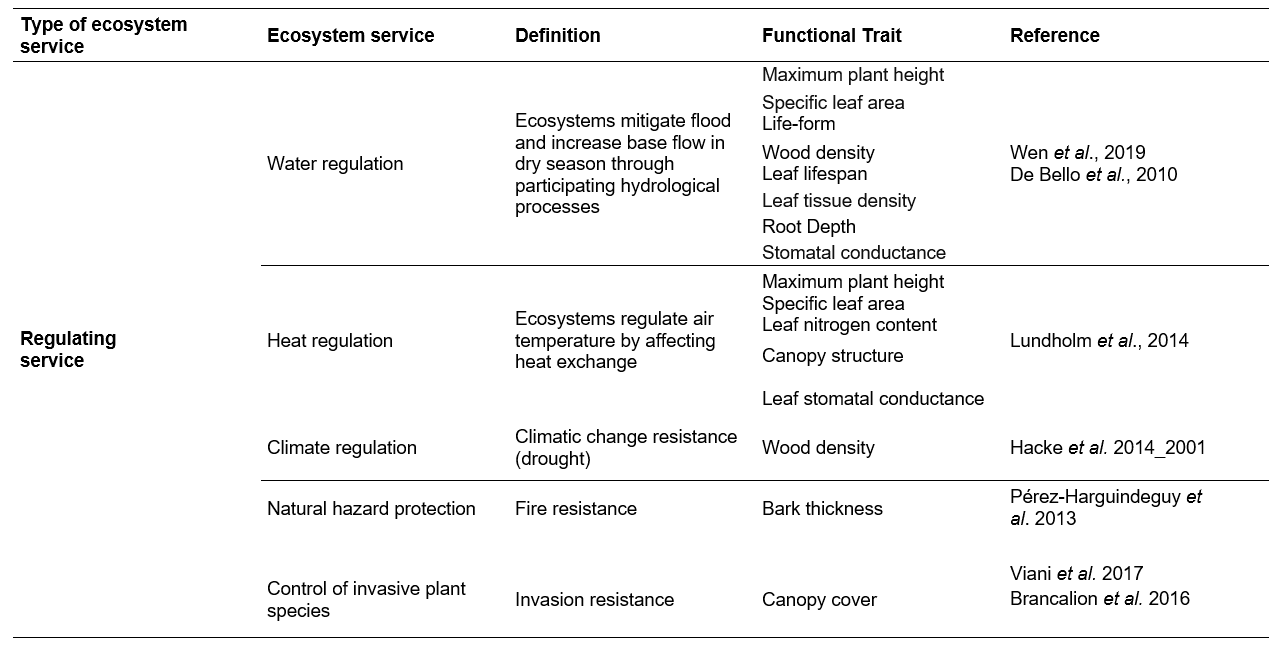
Table 1.2 – Continued Survey of Functional Characteristics Related to Different Ecosystem Services Proposed by the Millennium Ecosystem Assessment 2005 (MEA)
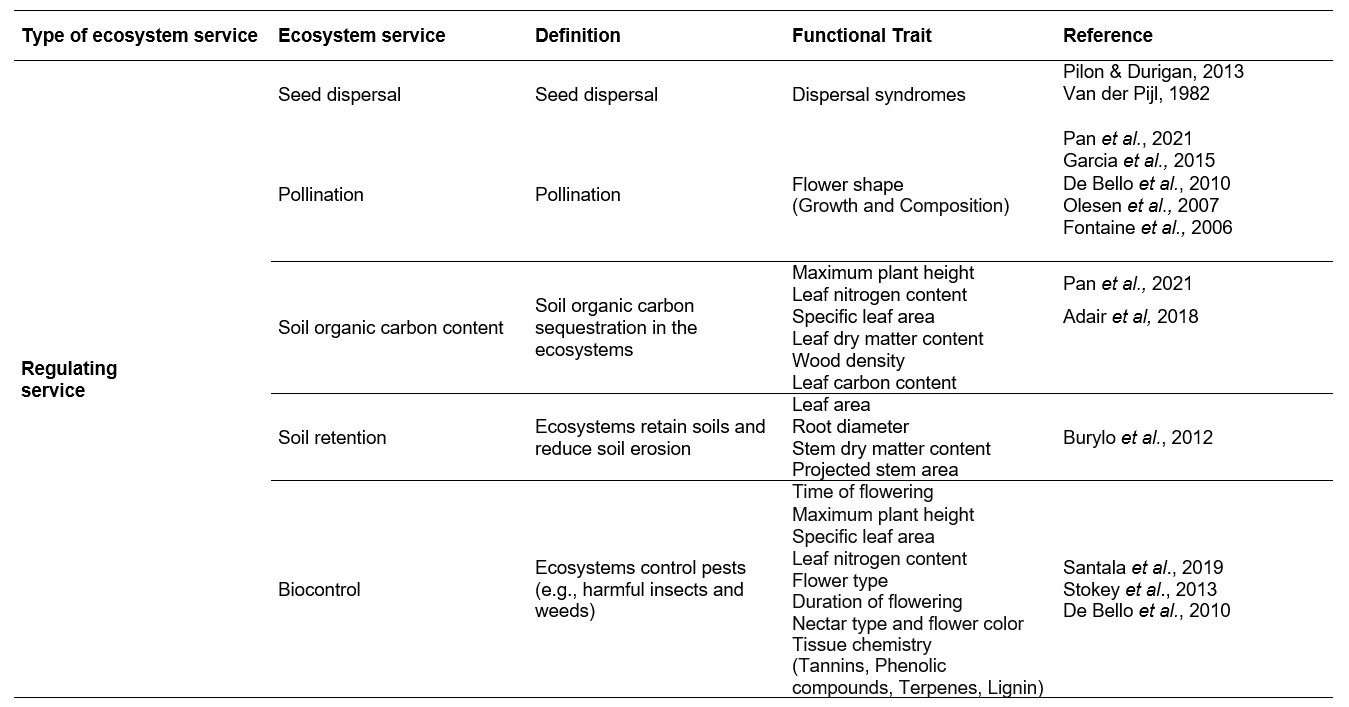
Table 1.3 – Continued Survey of Functional Characteristics Related to Different Ecosystem Services Proposed by the Millennium Ecosystem Assessment 2005 (MEA)
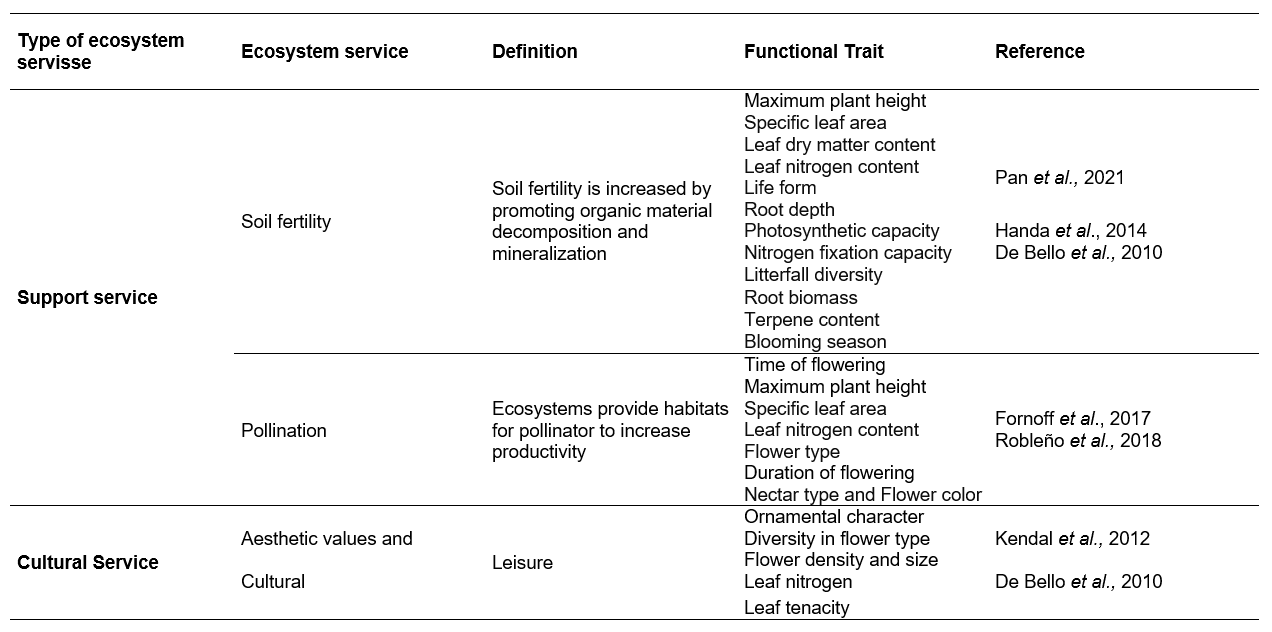
Merchant et al. (2023) advocate for the complementary use of functional traits in restoration actions, highlighting four reasons for the neglect of this topic in projects: distinct objectives and approaches, lack of operational structure, plant stock constraints, and lack of information on functional traits.
In this sense, studies that gather information from field research, databases, remote sensing, and ecological models are needed to establish patterns at spatial and temporal scales. However, the application of trait use in ecological models is limited by the availability of databases at smaller scales (He et al., 2019). In general, there is a lack of available information at regional scales for local and intraspecific characteristics (Siefert et al., 2015). To overcome these limitations, some international and local initiatives are being carried out to increase regional studies focusing on functional traits and making this information available in local databases.
It is worth noting that when considering the use of international plant functional traits databases, the accuracy of the information should be verified. Some databases may present biased analyses for some traits, such as specific leaf area, seed mass, leaf nitrogen per unit mass, maximum height, and maximum photosynthetic capacity per unit leaf area (Sandel; Corbin; Krupa, 2011). However, one way to minimize this issue is to use various standardized international databases to avoid possible sampling biases. There are some consolidated databases for functional traits: TRY/Plant Trait Database (Kattge et al., 2020; Kattge et al., 2011) that integrates 400 datasets, some of them being collective databases like (LEDA, GlopNet, BiolFlor, SID, EcoFlora, FRED). In addition to these, there are other database initiatives such as BIEN (Botanical Information and Ecology Network) characterized as a network of ecologists, botanists, and computer scientists working together to document global patterns of plant diversity, function, and distribution (Maitner et al., 2018), Neotropical Tree Community Database/TreeCo (De Lima et al., 2015; De Lima et al., 2020) which is the result of a project aimed at compiling and synthesizing existing knowledge on the structure and diversity of neotropical tree communities and the functional traits of their species, and the DRYAD Digital Repository (Zanne et al., 2009) which is a resource that curates research data making them discoverable, reusable, and citable. Besides these, there are still the FunAndes Database (Data on functional traits of plants in the tropical Andes) (Báez et al., 2022) and in Brazil the database of leaf traits of plants in different biomes and types of Brazilian vegetation called LT-Brazil (Mariano et al. 2021).
4. FINAL CONSIDERATIONS
In recent decades, we have seen advances in the use of functional traits in ecological restoration. However, it is worth noting that we still need more specific guidelines to guide public policies for ecological restoration in a practical and efficient manner.
The major challenge of the restoration decade in achieving global goals for revegetation of large degraded areas lies in the difficulty of applying theory to practical field aspects by restoration professionals. It is crucial that restoration projects control all phases (i.e., species selection, planning, monitoring, and evaluation).
On a global scale, much of the work involving functional traits seeks to measure attributes through systematic literature searches or queries in available databases. However, evaluating the functional aspect at a local or regional scale may yield better results, as it considers the local characteristics of each habitat. An important point is the low number of works associated with the ecosystem services to be restored and which attributes are related to these services.
Regarding tropical forests, it is noteworthy that the major challenge in using functional traits to select species for ecosystem services is due to these forests harboring a large diversity of species and few species with information on their functional traits. However, we can observe that functional traits, such as leaf traits, reproductive characteristics, architectural attributes, wood density, and ecophysiological traits, are increasingly being considered as important criteria for species selection in restoration projects.
It is evident that we should seek to have a broad view of restoration that addresses the widest possible range of aspects (organisms, species, populations, ecosystems, and landscapes) that need to be taken into account to assess the success of restoration projects. However, there are still major challenges in synthesizing and establishing systematic standards for structure, function, and composition elements since each biome presents different global, regional, and local characteristics. There is no fixed approach in restoration projects; the challenge in this regard is constant and flexible, and we must always stay updated with new advances in techniques, planting tools, monitoring, ecological indicators, among others.
Restoration ecology has shown significant advances in recent years, with growth and evolution in both theoretical and practical approaches. The current scenario highlights ecological restoration as a globally relevant theme. It is evident that further studies focusing on the development of models in restoration areas that more efficiently promote ecosystem services are still needed to achieve their effective functionality.
ACKNOWLEDGMENTS
The present work was supported by the Coordenação de Aperfeiçoamento de Pessoal de Nível Superior – Brazil (CAPES) – Funding Code 001 and by the Fundação Carlos Chagas Filho de Amparo à Pesquisa do Estado do Rio de Janeiro (FAPERJ). Marcelo Trindade Nascimento is supported by the Conselho Nacional de Desenvolvimento Científico e Tecnológico do Brasil (CNPq: 312567/2021-9) and by the Fundação Carlos Chagas Filho de Amparo à Pesquisa do Estado do Rio de Janeiro (FAPERJ E-26/201.007/2022). We thank Fabrício A. Carvalho, Igor S. Broggio, Karla M.P de Abreu, Luiz Fernando D. de Moraes, and Mariana A. Fantanin for their considerations and criticisms in the early versions of the manuscript.
REFERENCES
ADAIR, E. C. et al. Ecosystem context illuminates conflicting roles of plant diversity in carbon storage. Ecology Letters, v. 21, n. 11, p. 1604-1619, 2018.
ALLISON, S. D.; VITOUSEK, P. M. Rapid nutrient cycling in leaf litter from invasive plants in Hawai’i. Oecologia, v. 141, p. 612-619, 2004.
ARROYO‐RODRÍGUEZ, V. et al. Plant β‐diversity in fragmented rain forests: testing floristic homogenization and differentiation hypotheses. Journal of Ecology, v. 101, n. 6, p. 1449-1458, 2013.
BARALOTO, C. et al. Decoupled leaf and stem economics in rain forest Trees. Ecology Letters, Oxford, v. 13, n. 13, p. 13381347, 2010.
BÁEZ, S. et al. FunAndes–A functional trait database of Andean plants. Scientific data, v. 9, n. 1, p. 511, 2022.
BONN CHALLENGE. Bonn Challenge Report. IUCN. 2020. Disponível em: <https://www.bonnchallenge.org/resources/bonn-challenge-2020-report> Acesso: 20 jul 2023.
BRANCALION, P. H. et al. Global restoration opportunities in tropical rainforest landscapes. Science advances, v. 5, n. 7, p. eaav3223, 2019.
BRANCALION, P. H. S; HOLL, K. D. Functional composition trajectory: a resolution to the debate between Suganuma, Durigan, and Reid. Restoration Ecology, v. 24, n. 1, p. 1-3, 2016.
BRINCK, K. et al. High resolution analysis of tropical forest fragmentation and its impact on the global carbon cycle. Nature Communications, v. 8, n. 1, p. 14855, 2017.
BUNKER, D. E. et al. Species loss and aboveground carbon storage in a tropical forest. Science, v. 310, n. 5750, p. 10291031, 2005.
BURYLO, M. et al. Plant functional traits and species ability for sediment retention during concentrated flow erosion. Plant and Soil, v. 353, p. 135144, 2012.
CÁMARA-LERET, R. et al. Fundamental species traits explain provisioning services of tropical American palms. Nature Plants, v. 3, n. 2, p. 1-7, 2017.
CARLUCCI, M. B. et al. Functional traits and ecosystem services in ecological restoration. Restoration Ecology, v. 28, n. 6, p. 1372-1383, 2020.
CARUSO, C. M.; MASON, C. M.; MEDEIROS, J. S. The evolution of functional traits in plants: is the giant still sleeping?. International Journal of Plant Sciences, v. 181, n. 1, p. 1-8, 2020.
CDB – Convention on Biological Diversity. Strategic Plan 2021-2020. Aichi Biodiversity Targets. 2011. Disponível em: <https://www.cbd.int/sp/targets/>. Acesso: 9 abr 2023.
CHAVE, J. et al. Towards a worldwide wood economics spectrum. Ecology Letters, Oxford, v. 12, n. 4, p. 351-366, 2009.
CHAZDON, R; BRANCALION, P. Restoring forests as a means to many ends. Science, v. 365, n. 6448, p. 24-25, 2019.
CLOUGH, Y. et al. Combining high biodiversity with high yields in tropical agroforests. Proceedings of the National Academy of Sciences, v. 108, n. 20, p. 8311-8316, 2011.
CRAINE, J.M. et al. Functional traits, productivity and effects on nitrogen cycling of 33 grassland species. Functional Ecology, v. 16, n. 5, p. 563574, 2002.
DAVE, R. et al. Second Bonn Challenge progress report. Application of the Barometer in 2018. Gland, Switzerland: IUCN. xii + 80pp, 2019.
DE BELLO, F. et al. Towards an assessment of multiple ecosystem processes and services via functional traits. Biodiversity and Conservation, v. 19, n. 10, p. 2873-2893, 2010.
DE LIMA, R. A. et al. How much do we know about the endangered Atlantic Forest? Reviewing nearly 70 years of information on tree community surveys. Biodiversity and Conservation, v. 24, n. 9, p. 2135–2148, 2015.
DE LIMA, R. A. et al. The erosion of biodiversity and biomass in the Atlantic Forest biodiversity hotspot. Nature communications, v. 11, n. 1, p. 1-16, 2020.
DIAS, E. Atributos Funcionais Predizem Sobrevivência E Regeneração Arbórea Em Diferentes Modelos De Restauração Na Floresta Estacional Semidecidual. 2014. 103p. Dissertação (Mestrado em Agroecossistemas). Centro de Ciências Agrárias, Universidade Federal de Santa Catarina, Florianópolis. 2014.
DÍAZ, S.; CABIDO, M. Vive la différence: plant functional diversity matters to ecosystem processes. Trends in ecology & evolution, v. 16, n. 11, p. 646-655, 2001.
DÍAZ, S. et al. Incorporating plant functional diversity effects in ecosystem service assessments. Proceedings of the National Academy of Sciences, v. 104, n. 52, p. 20684-20689, 2007.
DÍAZ, S. et al. The global spectrum of plant form and function. Nature, v. 529, n. 7585, p. 167-171, 2016.
FONSECA,C.R. et al. Shifts in trait combinations along rainfall and phosphorus gradients. Journal of Ecology, v. 88, n. 6, p. 964-977, 2000.
FONTAINE, C. et al. Functional diversity of plant–pollinator interaction webs enhances the persistence of plant communities. PLoS biology, v. 4, n. 1, p. e1, 2006.
FORNOFF, F. et al. Functional flower traits and their diversity drive pollinator visitation. Oikos, v. 126, n. 7, p. 1020-1030, 2017.
GANN, G.D. et al. International principles and standards for the practice of ecological restoration. Second edition. Restoration Ecology, v. 27, n.1, p. 1-46, 2019.
GARCIA, L.C. et al. Flower functional trait responses to restoration time. Applied Vegetation Science, v. 18, n. 3, p. 402-412, 2015.
GARNIER, E; NAVAS, M. A. trait-based approach to comparative functional plant ecology: concepts, methods and applications for agroecology. A review. Agronomy for Sustainable Development, v. 32, n. 2, p. 365-399, 2012.
GFW – Global Forest Watch. Primary Forest Loss Global Forest Review. Washington, DC: World Resources Institute. 2022a. Disponível em: < https://research.wri.org/gfr/forest-extent-indicators/primary-forest-loss>. Acesso: 20 mai. 2023.
GFW – Global Forest Watch. Forest Loss Global Forest Review. Washington, DC: World Resources Institute. 2022b. Disponível em: < https://research.wri.org/gfr/forest-extent-indicators/forest-loss>. Acesso: 20 mai. 2023.
GORNISH, E. S. et al. Functional traits are used in restoration practice: a response to Merchant et al. (2022). Restoration Ecology, p. e13880, 2023.
GRIGULIS, K. et al. Relative contributions of plant traits and soil microbial properties to mountain grassland ecosystem services. Journal of Ecology, v. 101, n. 1, p. 47-57, 2013.
GRIME, J. P. et al. Integrated screening validates primary axes of specialisation in plants. Oikos, p. 259-281, 1997.
HACKE, U. G. et al. Trends in wood density and structure are linked to prevention of xylem implosion by negative pressure. Oecologia, v. 126, p. 457-461, 2001.
HANDA, I. T. et al. Consequences of biodiversity loss for litter decomposition across biomes. Nature, v. 509, n. 7499, p. 218-221, 2014.
HE, N. et al. Ecosystem traits linking functional traits to macroecology. Trends in Ecology & Evolution, v. 34, n. 3, p. 200-210, 2019.
HOLL, K. D. Factors limiting tropical rain forest regeneration in abandoned pasture: Seed rain, seed germination, microclimate, and soil 1. Biotropica, v. 31, n. 2, p. 229242, 1999.
KATTGE, J. et al. TRY plant trait database–enhanced coverage and open access. Global change biology, v. 26, n. 1, p. 119-188, 2020.
KATTGE, J. et al. TRY– a global database of plant traits. Global change biology, v. 17, n. 9, p. 2905-2935, 2011.
KENDAL, D.; WILLIAMS, K. J. H; WILLIAMS, N. S. G. Plant traits link people’s plant preferences to the composition of their gardens. Landscape and urban planning, v. 105, n. 1-2, p. 34-42, 2012.
KOLLMANN,J. et al. Integrating ecosystem functions into restoration ecology-recent advances and future directions. Restoration Ecology, v. 24, n. 6, p. 722-730, 2016.
LAUGHLIN, D. C. Applying trait-based models to achieve functional targets for theorydriven ecological restoration. Ecology Letters, v. 17, n. 7, p. 771–784, 2014.
LAVOREL, S. et al. Plant functional classifications: from general groups to specific groups based on response to disturbance. Trends in Ecology & Evolution, v. 12, n. 12, p. 474-478, 1997.
LAVOREL, S.; GARNIER, E. Predicting changes in community composition and ecosystem functioning from plant traits: revisiting the Holy Grail. Functional ecology, v. 16, n. 5, p. 545-556, 2002.
LOUREIRO, N. et al. Use of the trait-based approach in ecological restoration studies: a global review. Trees, p. 1-11, 2023.
LUNDHOLM, J. et al. Leaf and life history traits predict plant growth in a green roof ecosystem. PloS one, v. 9, n. 6, p. e101395, 2014.
MAITNER, B. S. et al. The bien r package: A tool to access the Botanical Information and Ecology Network (BIEN) database. Methods in Ecology and Evolution. 2018.
MANHÃES, A. P. et al. Functional trajectory for the assessment of ecological restoration success. Restoration Ecology, v. 30, n. 8, p. e13665, 2022.
MAPPIN, B. et al. Restoration priorities to achieve the global protected area target. Conservation Letters, v. 12, n. 4, p. e12646, 2019.
MARIANO, E. et al. LT‐Brazil: A database of leaf traits across biomes and vegetation types in Brazil. Global Ecology and Biogeography, v. 30, n. 11, p. 2136-2146, 2021.
MARTÍNEZ-GARZA, C.; BONGERS, F.; POORTER, L. Are functional traits good predictors of species performance in restoration plantings in tropical abandoned pastures ?. Forest Ecology and Management, v. 303, p. 35-45, 2013.
MCDONALD, T. et al. International standards for the practice of ecological restoration–including principles and key concepts. Society for Ecological Restoration: Washington, DC. SoilTec, Inc.,© Marcel Huijser, Bethanie Walder. 48p. 2016.
MEA – Millennium Ecosystem Assessment. Ecosystems and human wellbeing: wetlands and water. World Resources Institute, 2005.
MERCHANT, T. K. et al. Four reasons why functional traits are not being used in restoration practice. Restoration Ecology, v. 31, n. 3, p. e13788, 2023.
MMA – Ministério do Meio Ambiente. A Convenção sobre Diversidade Biológica – CDB. Cópia do decreto Legislativo. n.2, p.32, Brasília. 2000. Disponível em < https://www.gov.br/mma/pt-br/textoconvenoportugus.pdf> Acesso: 30 jul 2023.
MORAES, L. F. D. et al. Princípios e Padrões Internacionais para a prática da restauração ecológica. Segunda edição: Novembro 2019. Sociedade Ecológica de Restauração. Disponível em: <https://www.ser.org/page/SERDocuments> Acesso: 14 jul. 2023.
NOBLE, I. R.; GITAY, H. A. functional classification for predicting the dynamics of landscapes. Journal of Vegetation science, v. 7, n. 3, p. 329-336, 1996.
OLESEN, J. M. et al. The openness of a flower and its number of flower‐visitor species. Taxon, v. 56, n. 3, p. 729-736, 2007.
OLSON, D. M.; DINERSTEIN, E. The Global 200: Priority ecoregions for global conservation. Annals of the Missouri Botanical garden, p. 199-224, 2002.
OSTERTAG, R. et al. Using plant functional traits to restore Hawaiian rainforest. Journal of Applied Ecology, v. 52, n. 4, p. 805-809, 2015.
OUZZANI, M. et al. Rayyan—a web and mobile app for systematic reviews. Systematic reviews, v. 5, p. 1-10, 2016.
PALMA, A. C. et al. Enhancing plant diversity in secondary forests. Frontiers in Forests and Global Change, v. 3, p. 571352, 2020.
PALMA, A. C.; LAURANCE, S. G. W. A review of the use of direct seeding and seedling plantings in restoration: What do we know and where should we go? Applied Vegetation Science, v. 18, n. 4, p. 561–568, 2015.
PAN, Q. et al. Effects of plant functional traits on ecosystem services: A review. Chinese Journal of Plant Ecology, v. 45, n. 6, p. 1140–1153, 2021.
PÉREZ-HARGUINDEGUY, N. et al. New handbook for standardised measurement of plant functional traits worldwide. Aust. Bot. 61, 167– 234. 2013.
PETISCO-SOUZA, A. C. et al. Minding the gap: range size and economic use drive functional trait data shortfall in the Atlantic Forest. BioRxiv, 2020.
PILON, N. A. L.; DURIGAN, G. Critérios para indicação de espécies prioritárias para a restauração da vegetação de cerrado. Scientia Forestalis, p. 389-399, 2013.
POORTER, L. et al. Are functional traits good predictors of demographic rates? Evidence from five Neotropical forests. Ecology, New York, v. 89, n. 7, p. 1908-1920, 2008.
QUÉTIER, F.; THÉBAULT, A.; LAVOREL, S. Plant traits in a state and transition framework as markers of ecosystem response to land‐use change. Ecological monographs, v. 77, n. 1, p. 33-52, 2007.
REICH, P. B. The world‐wide ‘fast–slow’ plant economics spectrum: a traits manifesto. Journal of ecology, v. 102, n. 2, p. 275-301, 2014.
ROBLEÑO, I. et al. Using the response–effect trait framework to quantify the value of fallow patches in agricultural landscapes to pollinators. Applied Vegetation Science, v. 21, n. 2, p. 267-277, 2018.
ROSENFIELD, M. F.; MÜLLER, S. C. Functional ecology as a tool for planning and monitoring ecosystems restoration. Oecologia Australis, v. 24, n. 3, p. 550–565, 2020.
ROSENFIELD, M.F. Processos ecossistêmicos e funcionalidade de florestas em restauração. 2017, 181p. Tese (Doutorado em Ecologia). Universidade Federal do Rio Grande do Sul, Porto Alegre. 2017.
ROTHER, D. C. et al. Ecological restoration increases conservation of taxonomic and functional beta diversity of woody plants in a tropical fragmented landscape. Forest Ecology and Management, v. 451, p. 117538, 2019.
SANDEL, B.; CORBIN, J. D.; KRUPA, M. Using plant functional traits to guide restoration: A case study in California coastal grassland. Ecosphere, v. 2, n. 2, p. 116, 2011.
SANTALA, K. et al. Managing conservation values and tree performance: Lessons learned from 10 year experiments in regenerating eastern white pine (Pinus strobus L.). Forest Ecology and Management, v. 432, p. 748-760, 2019.
SCHULZE, E.D. et al. Carbon and nitrogen isotope discrimination and nitrogen nutrition of trees along a rainfall gradient in northern Australia. Functional Plant Biology, v. 25, n. 4, p. 413-425, 1998.
SER – Society for Ecological Restoration. Princípios da SER International sobre a restauração ecológica. Grupo de Trabalho sobre Ciência e Política – versão 2. Tucson: SER, 2004. Disponível em: <https://www.ser.org/page/SERDocuments>. Acesso: 14 jul. 2023.
SHIMAMOTO, C. Y. et al. Restoration of ecosystem services in tropical forests: A global meta-analysis. PLoS ONE, v. 13, n. 12, p. 1–16, 2018.
SIEFERT, A. et al. A global meta‐analysis of the relative extent of intraspecific trait variation in plant communities. Ecology letters, v.18, n. 12, p. 1406-1419, 2015.
STORKEY, J. et al. Using functional traits to quantify the value of plant communities to invertebrate ecosystem service providers in arable landscapes. Journal of Ecology, v. 101, n. 1, p. 38-46, 2013.
SUDING, K. et al. Committing to ecological restoration. Science, v. 348, n. 6235, p. 638-640, 2015.
UNEP – United Nations Environment Programme. Resolution adopted by the General Assembly on 1 March 2019. New York. 2019. Disponível em: < https://documents.un.org/doc/undoc/gen/n19/060/16/pdf/n1906016.pdf?token=SJsp18lS6AHLiqIpEX&fe=true > Acesso: 14 jul. 2023.
VAN DER PIJL, L. Principles of Dispersal in Higher Plants, Berlin: Spring-Verlag, 1982.
VIANI, R. A. et al. Protocol for monitoring tropical forest restoration: perspectives from the Atlantic Forest Restoration Pact in Brazil. Tropical Conservation Science, v. 10, p. 1940082917697265, 2017.
VIOLLE, C. et al. Let the concept of trait be functional!. Oikos, v. 116, n. 5, p. 882-892, 2007.
VOLIS, S.; ORMANBEKOVA, D.; YERMEKBAYEV. K. Role of phenotypic plasticity and population differentiation in adaptation to novel environmental conditions. Ecology and Evolution, v. 5, p. 3818–3829, 2015.
WEIHER, E. et al. Advances, challenges and a developing synthesis of ecological community assembly theory. Philosophical Transactions of the Royal Society B: Biological Sciences, v. 366, n. 1576, p. 2403-2413, 2011.
WEIHER, E. et al. Challenging Theophrastus: a common core list of plant traits for functional ecology. Journal of vegetation science, v. 10, n. 5, p. 609-620, 1999.
WEN, Z. et al. Functional diversity overrides community weighted mean traits in linking land-use intensity to hydrological ecosystem services. Science of the Total Environment, v. 682, p. 583-590, 2019.
WRIGHT, I. J. et al. The worldwide leaf economics spectrum. Nature, v. 428, n. 6985, p. 821-827, 2004.
WRIGHT, I. J.; REICH, P. B.; WESTOBY, M. Strategy shifts in leaf physiology, structure and nutrient content between species of high‐and low‐rainfall and high‐and low‐nutrient habitats. Functional Ecology, v. 15, n. 4, p. 423-434, 2001.
ZAKHAROVA, L.; MEYER, K. M.; SEIFAN, M. Trait-based modelling in ecology: A review of two decades of research. Ecological Modelling, v. 407, p. 108703, 2019.
ZANNE, A. E. et al. Data from: Towards a worldwide wood economics spectrum. Dryad Digital Repository, 2009. Disponível em: <https://datadryad.org/stash/dataset/doi:10.5061/dryad.234>. Acesso: 10 mai. 2023.
ZIRBEL, C. R. et al. Plant functional traits and environmental conditions shape community assembly and ecosystem functioning during restoration. Journal of Applied Ecology, v. 54, n. 4, p. 1070–1079, 2017.
ZUPO, T. et al. Trends and knowledge gaps on ecological restoration research in the Brazilian Atlantic Forest. Restoration Ecology, v. 30, n. 8, p. 1–12, 2022.
NOTE
The authors used the AI ChatGPT 3.5 to assist in the grammatical review and spelling analysis of the document. However, all searches for content, classification of article quality, and content dissertation were done authorially.
[1] Master’s degree in Ecology and Natural Resources, State University of Northern Rio de Janeiro Darcy Ribeiro (2019). ORCID: https://orcid.org/0000-0002-4973-3606. Currículo Lattes: http://lattes.cnpq.br/9550083180869691.
[2] Advisor. PhD in Ecology, University of Stirling, Scotland (1994). ORCID: https://orcid.org/0000-0003-4492-3344. Currículo Lattes: http://lattes.cnpq.br/3704305950005564.
Material received: November 7, 2023.
Material peer-reviewed: November 27, 2023.
Edited material approved by the authors: February 13, 2024.

